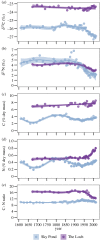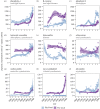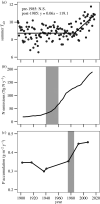Nutrients and warming interact to force mountain lakes into unprecedented ecological states
- PMID: 32635862
- PMCID: PMC7423480
- DOI: 10.1098/rspb.2020.0304
Nutrients and warming interact to force mountain lakes into unprecedented ecological states
Abstract
While deposition of reactive nitrogen (N) in the twentieth century has been strongly linked to changes in diatom assemblages in high-elevation lakes, pronounced and contemporaneous changes in other algal groups suggest additional drivers. We explored the origin and magnitude of changes in two mountain lakes from the end of the Little Ice Age at ca 1850, to ca 2010, using lake sediments. We found dramatic changes in algal community abundance and composition. While diatoms remain the most abundant photosynthetic organisms, concentrations of diatom pigments decreased while pigments representing chlorophytes increased 200-300% since ca 1950 and total algal biomass more than doubled. Some algal changes began ca 1900 but shifts in most sedimentary proxies accelerated ca 1950 commensurate with many human-caused changes to the Earth System. In addition to N deposition, aeolian dust deposition may have contributed phosphorus. Strong increases in summer air and surface water temperatures since 1983 have direct and indirect consequences for high-elevation ecosystems. Such warming could have directly enhanced nutrient use and primary production. Indirect consequences of warming include enhanced leaching of nutrients from geologic and cryosphere sources, particularly as glaciers ablate. While we infer causal mechanisms, changes in primary producer communities appear to be without historical precedent and are commensurate with the post-1950 acceleration of global change.
Keywords: chlorophyte; diatom; mountain lake; nitrogen deposition; palaeolimnology; warming.
Conflict of interest statement
We declare we have no competing interests.
Figures




References
-
- Catalan J, et al. 2013. Global change revealed by palaeolimnological records from remote lakes: a review. J. Paleolimnol. 49, 513–535. (10.1007/s10933-013-9681-2) - DOI
-
- Dubois N, et al. 2018. First human impacts and responses of aquatic systems: a review of palaeolimnological records from around the world. Anthr. Rev. 5, 28–68. (10.1177/2053019617740365) - DOI
-
- Moser KA, et al. 2019. Mountain lakes: eyes on global environmental change. Glob Planet. Change 178, 77–95. (10.1016/j.gloplacha.2019.04.001) - DOI
-
- Steffen W, Broadgate W, Deutsch L, Gaffney O, Ludwig C. 2015. The trajectory of the anthropocene: the great acceleration. Anthr. Rev. 2, 81–98. (10.1177/2053019614564785) - DOI
-
- Baron JS, Del Grosso S, Ojima DS, Theobald DM, Parton WJ. 2004. Nitrogen emissions along the Colorado Front Range: response to population growth, land and water use change, and agriculture. Wash DC Am. Geophys. Union Geophys. Monogr. Ser. 153, 117–127. (10.1029/153GM10) - DOI
Publication types
MeSH terms
Substances
Associated data
LinkOut - more resources
Full Text Sources
Medical

